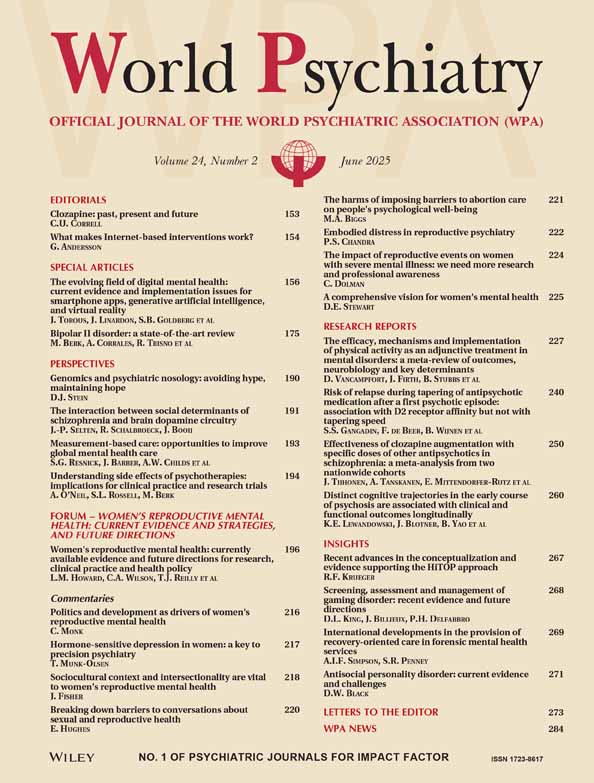Diagnostic markers for schizophrenia: do we actually know what we're looking for?
Lawrie et al have written a thoughtful review of the evidence for diagnostic markers of schizophrenia, covering epidemiological risk factors, physical signs, neurocognitive and neuroimaging features and gene- or protein-based biomarkers. However, behind this mass of data lie four unasked questions, the answers to which are critical to the success of any attempt to improve diagnosis.
What is the illness we are trying to diagnose? It is commonplace nowadays for researchers to acknowledge that schizophrenia is not actually a unitary disorder, but is more likely to be a group of disorders that share syndromal characteristics. A brief examination of a number of neuropsychiatric disorders demonstrates that they can symptomatically be indistinguishable from schizophrenia. For example, Niemann-Pick type C disease may present with psychosis as the sole initial manifestation 1, as may metachromatic leukodystrophy 2. Yet, their genetic bases are completely different, and by pooling them as “psychotic disorders” we would merely add noise to our search for diagnostic markers. It is trite, but nonetheless true, that a clear definition of what we are trying to diagnose is key.
Should different dimensions of schizo- phrenia be considered separately? As Lawrie et al note, the current gold standard diagnosis of “schizophrenia” is “tarnished”. An alternative approach to diagnosing “schizophrenia” is to “deconstruct” the syndrome 3,4. That is, to consider various dimensions of the “illness” and investigate risk factors, markers, course, outcome and treatment for these. For example, at a basic level, positive psychotic symptoms and negative symptoms could be examined separately. This may be too simplistic a division. Positive symptoms are likely to be heterogenous in origin and outcome, and could be divided into three (bizarre experiences, persecutory ideation and magical thinking) 5, four (the previous three but perceptual abnormality as well) or even five factors (essentially the previous four but with magical ideation divided into paranormal beliefs and grandiosity). These positive symptoms are likely to have different associations with other psychopathological dimensions, different underlying aetiologies, and hence different risk factors, markers and course. The recent finding that negative symptoms and conceptual disorganization co-occur in the community provides evidence for this approach. This builds on past work that has long suggested that there is a “neurodevelopment” or “nuclear syndrome” characterized by early onset, male gender, and cognitive impairment 6, that is likely to have a poorer prognosis, in terms of functional recovery, than “schizophrenia” without these features. Kirkpatrick and colleagues have referred to this syndrome, with the addition of marked avolition, as the deficit syndrome 7. It is on this background of thinking and evidence that the Psychosis Work Group of the DSM-5 Committee is planning on testing a set of dimensions, including hallucinations, delusions, disorganization, restricted affect, avolition, cognition impairment, anxiety, depression and mania 8. These dimensions could therefore become targets for research and treatment development 8. It may well be that people currently diagnosed as “schizophrenia” will require different treatments from each other depending on the relative prominence of each dimension, which is likely to be more precise an indicator of underlying pathology than a simple diagnosis of “schizophrenia”. The blanket approach of antipsychotics and perhaps cognitive-behavioural therapy may not be appropriate to all. For example, some individuals with apparent “schizophrenia”, but without evidence of neurodevelopmental pathology, may recover in the absence of antipsychotics 9.
At what stage in the illness are we trying to diagnose it? Schizophrenia does not present similarly at all stages of the illness. Lawrie et al provide a good overview of attempts at early diagnosis, although many of the studies they cite do not have schizophrenia as the final outcome. For example, many of the clinical high risk studies (including our own) use a transition to “psychosis” as the outcome of interest 10.
Finally, a critical question for the psychiatric community generally is: what difference does a diagnosis of schizophrenia make? Does it affect treatment or prognosis? A patient presenting with positive psychotic symptoms in the absence of an obvious immediate cause (such as seizures or recent drug use) is likely to be treated initially with a low dose of antipsychotics, and perhaps provided with a psychological intervention such as cognitive behavioural therapy. Whether or not this patient has a schizophrenia diagnosis, this initial treatment regimen is unlikely to change. Equally, a diagnosis of schizophrenia (at least, one reached after only a brief period of illness) does not provide much indication of prognosis. Recovery is common, as is diagnostic revision.
The aim of Lawrie et al is laudable — to more precisely be able to diagnose schizophrenia through the use of a clinical arsenal, from blood tests and neuroimaging to good history taking and physical examination. However, such an approach is doomed without first establishing the nature of the illness, the extent to which diagnostic markers vary with course, and the relevance of the diagnosis for treatment and prognosis.
Acknowledgements
S.J. Wood has been the recipient of a Clinical Career Development Award from the National Health and Medical Research Council (NHMRC). A.R. Yung is the recipient of a Senior Research Fellowship, also from the NHMRC.




